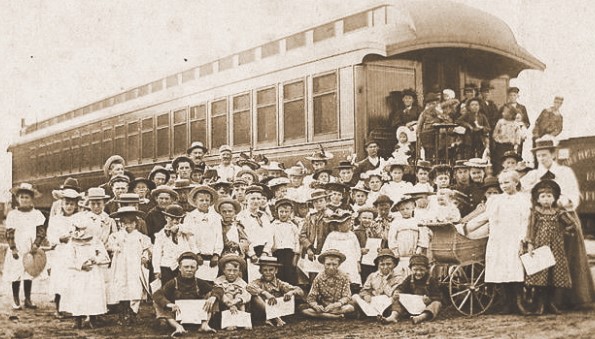
By Russ Wielt

Photo source: Texas Standard
|
In 1852, over 175,000 immigrants arrived in America. In 1854, the number rose to over 250,000 with the port of New York being the main arrival point. New York City became a "boiling pot" of chaotic living conditions with widespread disease, crime, break down of family life, and innocent children suffering. The NYC chief of police estimated 10,000 children in the city in 1853 were uncared for. Charles Loring Brace, a young minister, saw a dire need and felt a strong desire to help. He turned from a well to do, secure lifestyle to that of a poorly paid social worker by becoming the first secretary to the newly formed Children's Aid Society, CAS. In 1854, the organized CAS group went west. Forty children of workable age were sent to Michigan. The placing was successful, thus the Free Home Placing Out began and did not stop until the late 1920's or early '30's. Western agents visited towns asking volunteers to form local communities to screen perspective homes for the soon to arrive children. Back in NYC children chosen for the trip would be placed in the care of an agent, or agents, who saw to their needs. Stopping at designated towns along the way people met the group and agent, to choose a child. A contract was signed and a child placed. [Copies of contracts may be obtained from the OTHSA, Inc., by members.] Agents followed up on the placements with visits. In the event the placing was not a good choice, the Society removed the child and placed he/she again.In 1865, The New York Foundling Asylum was founded by the Sisters of Charity of Saint Vincent DePaul with 5 dollars and an empty building. In the beginning, a basket placed in the entryway received unwanted infants with no questions asked. A nun, on duty nearby would quickly retrieved the child and take it to be cared for. Sister Teresa Vincent and Sister Irene Fitzgerald were in charge of the new child saving mission which in later years became the New York Foundling Hospital. In 1872, "Baby Trains" were sent out with infants and small children to be placed with families who agreed to raise them in the Catholic faith. The Foundling used an indenture form when placing children. This gave them legal authority to remove the child from a household at anytime (otherwise the child was released from the indenture at age 18). Many families looked upon this document as a form of adoption and did not proceed with legal adoption. The Foundling sent large groups of children west in leased railroad cars with agents and nurses to care for them until their destination was reached. Tags sewn onto the child's clothing gave a name, birth date and a name of the pre-selected family who had been sent a matching card. A number was assigned to each child. When the train arrived, a match was made, papers signed and the child delivered. The New England Home for Little Wanderers in Boston also sent children west to be placed. They placed children as early as 1865 but stopped the practice in 1903. Other societies such as The Chicago Home Society and the Minnesota Home Society also placed children in other states. Between 1854 and 1929 an estimated 150,000 orphaned, abandoned, homeless children and poor families were placed out in what we today know as the Orphan Trains Era. This period of mass relocation of children in the U.S. is widely recognized as the beginning of documented foster care in America. Submitted Aug 5, 1999 |
For corrections or additions, please contact me: Sandy Bauer